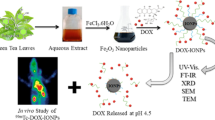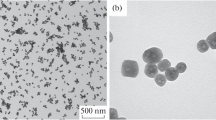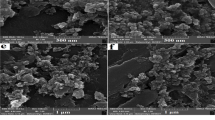Abstract
Purpose
This study aimed to investigate the impact of the size of X-ray iodinated contrast agent in nano-emulsions, on their toxicity and fate in vivo.
Methods
A new compound, triiodobenzoate cholecalciferol, was synthetized, formulated as nano-emulsions, and followed after i.v. administration in mice by X-ray imaging (micro computed tomography). Physicochemical characterization and process optimization allowed identifying a good compromise between X-ray contrasting properties, monodispersity and stability. This also allowed selecting two formulations with different sizes, hydrodynamic diameters of 55 and 100 nm, but exactly the same composition. In vitro experiments were performed on two cell lines, namely hepatocytes (BNL-CL2) and macrophages (RAW264.7).
Results
Cell viability studies, cell uptake observations by confocal microscopy, and uptake quantification by fluorimetry, disclosed clear differences between two formulations, as well as between two types of cell lines. After i.v. injection of the two iodinated nano-emulsions in mice, CT scans provided the quantification of the pharmacokinetics and biodistributions. We finally showed that the size in the nano-emulsions has not a real impact on the pharmacokinetics and biodistributions, but has a strong influence on their toxicity, corroborating the in vitro results.
Conclusions
This study shows that the size of the nanocarrier significantly matters, likely due to highly different interactions with cells and tissues.

A study on the effect of the size of cholecciferol nano-emulsions, on their in vivo becoming, through X-ray imaging modality.










Similar content being viewed by others
Abbreviations
- CDCl3 :
-
Deuterated chloroform
- CT:
-
Computed tomography
- DCC:
-
N,N′-dicyclohexylcarbodiimide
- DLS:
-
Dynamic light scattering
- DMAP:
-
4-dimethylaminopyridine
- DMEM:
-
Dulbecco’s modified Eagle medium
- DMSO:
-
Dimethyl sulfoxide
- EPR:
-
Enhanced permeation and retention
- FBS:
-
Fetal bovine serum
- HBSS:
-
Hank’s balanced salt solution
- microCT:
-
Micro computed tomography
- MRI:
-
Magnetic resonance imaging
- MTT:
-
3-(4,5 dimethylthiazol-2-yl)-2,5-diphenyltetrazolium bromide
- NPs:
-
Nanoparticles
- OR:
-
Oil ratio
- PBS:
-
Phosphate buffered saline
- PDI:
-
Polydispersity index
- PEG:
-
Polyethyleneglycol
- PET:
-
Positron emission tomography
- RES:
-
Reticuloendothelial system
- SOR:
-
Surfactant / (surfactant + oil) weight ratio
- SOWR:
-
(surfactant + oil) / (surfactant + oil + water) weight ratio
- SPECT:
-
Single photon emission computed tomography
- TIBA:
-
2,3,5-Triiodobenzoic acid
- TMS:
-
Tetramethylsilane
References
Patel HM. Serum opsonins and liposomes: their interaction and opsonophagocytosis. Crit Rev Ther Drug Carrier Syst. 1992;9:39–90.
Chonn A, Semple SC, Cullis PR. Association of blood proteins with large unilamellar liposomes in vivo. J Biol Chem. 1992;267:18759–65.
Patil S, Gawali S, Patil S, Basu S. Synthesis, characterization and in vitro evaluation of novel vitamin D3 nanoparticles as a versatile platform for drug delivery in cancer therapy. J Mater Chem B. 2013;1:5742–50.
Zhang G, Yang Z, Lu W, Zhang R, Huang Q, Tian M, et al. Influence of anchoring ligands and particle size on the colloidal stability and in vivo biodistribution of polyethylene glycol-coated gold nanoparticles in tumor-xenografted mice. Biomaterials. 2009;30:1928–36.
Aggarwal P, Hall JB, McLeland CB, Dobrovolskaia MA, McNei SE. Nanoparticle interaction with plasma proteins as it relates to particle biodistribution, biocompatibility and therapeutic efficacy. Adv Drug Deliv Rev. 2009;61:428–37.
Antonand N, Vandamme TF. Nanotechnology for computed tomography: a real potential recently disclosed. Pharm Res. 2014;31:20–34.
Maeda H, Wu J, Sawa T, Matsumura Y, Hori K. Tumor vascular permeability and the EPR effect in macromolecular therapeutics: a review. J Control Release. 2000;65:271–84.
Hirsjärvi S, Dufort S, Bastiat G, Saulnier P, Passirani C, Coll J-L, et al. Surface modification of lipid nanocapsules with polysaccharides: from physicochemical characteristics to in vivo aspects. Acta Biomater. 2013;9:6686–93.
Hallouard F, Anton N, Choquet P, Constantinesco A, Vandamme TF. Iodinated blood pool contrast media for preclinical X-ray imaging applications – a review. Biomaterials. 2010;31:6249–68.
Li X, Anton N, Zuber G, Vandamme TF. Contrast agents for preclinical targeted X-ray imaging. Adv Drug Deliv Rev. 2014;76:116–33.
Attia MF, Anton N, Chiper M, Akasov R, Anton H, Messaddeq N, et al. Biodistribution of X-ray iodinated contrast agent in nano-emulsions is controlled by the chemical nature of the oily core. ACS Nano. 2014;8:10537–50.
Holick MF, Tian XQ, Allen M. Evolutionary importance for the membrane enhancement of the production of vitamin D3 in the skin of poikilothermic animals. Proc Natl Acad Sci U S A. 1995;92:3124–6.
MacLaughlin JA, Anderson RR, Holick MF. Spectral character of sunlight modulates photosynthesis of previtamin D3 and its photoisomers in human skin. Science. 1982;216:1001–3.
Porter CJH, Trevaskis NL, Charman WN. Lipids and lipid-based formulations: optimizing the oral delivery of lipophilic drugs. Nat Rev Drug Discov. 2007;6:231–48.
Holickand MF, Garabedian M. Vitamin D: photobiology, metabolism, mechanism of action, and clinical applications. In: Favus MJ, editor. Primer on the metabolic bone diseases and disorders of mineral metabolism. Washington: American Society for Bone and Mineral Research; 2006. p. 129–37.
Holick MF. Phylogenetic and evolutionary aspects of vitamin D from phytoplankton to humans. In: Pangand PKT, Schreibman MP, editors. Vertebrate endocrinology: fundamentals and biomedical implications. San Diego: Academic Press, Inc.; 1989.
Holick MF. Physiology, molecular biology, and clinical applications. In: Holick MF, editor. Vitamin D and Health: evolution, biologic functions, and recommended dietary intakes for vitamin D. Totowa: Humana Press Inc.; 2009. p. 3–35.
Khlebtsovand N, Dykman L. Biodistribution and toxicity of engineered gold nanoparticles: a review of in vitro and in vivo studies. Chem Soc Rev. 2011;40:1647–71.
Oberdörster G, Oberdörster E, Oberdörster J. Concepts of nanoparticle dose metric and response metric. Environ Health Perspect. 2007;115:A290–4.
Fadeelaand B, Garcia-Bennett AE. Better safe than sorry: understanding the toxicological properties of inorganic nanoparticles manufactured for biomedical applications. Adv Drug Deliv Rev. 2010;62:362–74.
Chono S, Tanino T, Seki T, Morimoto K. Uptake characteristics of liposomes by rat alveolar macrophages: influence of particle size and surface mannose modification. J Pharm Pharmacol. 2007;59:75–80.
Osaki F, Kanamori T, Sando S, Sera T, Aoyama Y. A quantum dot conjugated sugar ball and its cellular uptake. On the size effects of endocytosis in the subviral region. J Am Chem Soc. 2004;126:6520–1.
Winand KY, Feng S-S. Effects of particle size and surface coating on cellular uptake of polymeric nanoparticles for oral delivery of anticancer drugs. Biomaterials. 2005;26:2713–22.
Foged C, Brodin B, Frokjaera S, Sundbladb A. Particle size and surface charge affect particle uptake by human dendritic cells in an in vitro model. Int J Pharm. 2005;298:315–22.
Chithrani BD, Ghazani AA, Chan WCW. Determining the size and shape dependence of gold nanoparticle uptake into mammalian cells. Nano Lett. 2006;6:662–8.
Lu F, Wu S-H, Hung Y, Mou C-Y. Size effect on cell uptake in well-suspended. Uniform mesoporous silica nanoparticles. Small. 2009;5:1408–13.
Lee K-D, Nir S, Papahadjopoulos D. Quantitative analysis of liposome-cell interactions in vitro: rate constants of binding and endocytosis with suspension and adherent J774 cells and human monocytes. Biochemistry. 1993;32:889–99.
Szebeni J, Muggia FM, Alving CR. Complement activation by cremophor EL as a possible contributor to hypersensitivity to paclitaxel: an in vitro study. J Natl Cancer Inst. 1998;90:300–6.
Anton N, Benoit J-P, Saulnier P. Design and production of nanoparticles formulated from nano-emulsion templates—a review. J Control Release. 2008;128:185–99.
Anton N, Gayet P, Benoit J-P, Saulnier P. Nano-emulsions and nanocapsules by the PIT method: an investigation on the role of the temperature cycling on the emulsion phase inversion. Int J Pharm. 2007;344:44–52.
Antonand N, Vandamme TF. The universality of low-energy nano-emulsification. Int J Pharm. 2009;377:142–7.
Klymchenko AS, Roger E, Anton N, Anton H, Shulov I, Vermot J, et al. Highly lipophilic fluorescent dyes in nano-emulsions: towards bright nonleaking nano-droplets. RSC Adv. 2012;2:11876–86.
Li X, Anton N, Zuber G, Zhao M, Messaddeq N, Hallouard F, et al. Iodinated α-tocopherol nano-emulsions as non-toxic contrast agents for preclinical X-ray imaging. Biomaterials. 2013;34:481–91.
Vonarbourg A, Passirani C, Saulnier P, Simard P, Leroux JC, Benoit JP. Evaluation of pegylated lipid nanocapsules versus complement system activation and macrophage uptake. J Biomed Mater Res A. 2006;78:620–8.
Ohand N, Park JH. Endocytosis and exocytosis of nanoparticles in mammalian cells. Int J Nanomedicine. 2014;9:51–3.
Shang L, Nienhaus K, Nienhaus GU. Engineered nanoparticles interacting with cells: size matters. J Nanobiotechnol. 2014;12:1–11.
Xu A, Yao M, Xu G, Ying J, Ma W, Li B, et al. A physical model for the size-dependent cellular uptake of nanoparticles modified with cationic surfactants. Int J Nanomedicine. 2012;7:3547–54.
Willekens I, Lahoutte T, Buls N, Vanhove C, Deklerck R, Bossuyt A, et al. Time-course of contrast enhancement in spleen and liver with Exia 160, Fenestra LC, and VC. Mol Imaging Biol. 2009;11:128–35.
Nebuloni L, Kuhn GA, Müller R. A comparative analysis of water-soluble and blood-pool contrast agents for in vivo vascular imaging with micro-CT. Acad Radiol. 2013;20:1247–55.
Boll H, Nittka S, Doyon F, Neumaier M, Marx A, Kramer M, et al. Micro-CT based experimental liver imaging using a nanoparticulate contrast agent: a longitudinal study in mice. PLoS ONE. 2011;6:e25692.
Hallouard F, Briançon S, Anton N, Li X, Vandamme TF, Fessi H. Influence of diblock co-polymer PCL-mPEG and of various iodinated oils on the formulation by the emulsion-diffusion process of radiopaque polymeric nanoparticles. J Pharm Sci. 2013;102:4150–8.
Hallouard F, Briançon S, Anton N, Li X, Vandamme TF, Fessi H. Iodinated nano-emulsions as contrast agents for preclinical X-ray imaging, impact of the free surfactants on the pharmacokinetics. Eur J Pharm Biopharm. 2013;83:54–62.
ACKNOWLEDGMENTS AND DISCLOSURES
The authors would like to thank for grant “Attractivité IDEX 2013” within University of Strasbourg, France.
Author information
Authors and Affiliations
Corresponding author
Rights and permissions
About this article
Cite this article
Attia, M.F., Anton, N., Akasov, R. et al. Biodistribution and Toxicity of X-Ray Iodinated Contrast Agent in Nano-emulsions in Function of Their Size. Pharm Res 33, 603–614 (2016). https://doi.org/10.1007/s11095-015-1813-0
Received:
Accepted:
Published:
Issue Date:
DOI: https://doi.org/10.1007/s11095-015-1813-0




